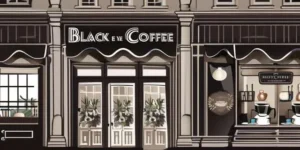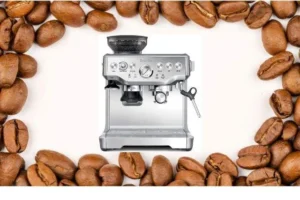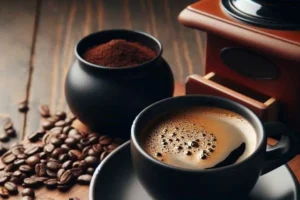Exploring Scandinavian Coffee Culture
Coffee culture means the traditions around drinking coffee. Scandinavian coffee culture is unique. Their coffee culture is old but also new. It has specific brewing, iconic drinks, loved rituals, and values.
At the heart is the Swedish fika. Fika is more than coffee. It is quality time with friends over coffee, baked goods, and talk. Fika shows Scandinavian ideals of cozy, equal, sustainable, and work-life balance.
Scandinavians care about the experience, ethics, art, and quality coffee. Their cafes are stylish but also warm and welcoming.
Overall, Scandinavian coffee culture combines tradition and innovation. It brings people together in a comforting, quirky, equal way.
Scandinavian Coffee Culture Key Takeaways
- Fika: Fika is a Swedish tradition emphasizing equality, sustainability, and quality time over coffee with friends.
- Ethical & Sustainable: Scandinavian coffee culture is committed to ethical sourcing and sustainability, ranking among the world’s top coffee consumers.
- Diverse Brewing: It combines traditional and modern methods, offering unique and flavorful brews.
- Global Impact: It influences global coffee trends and fosters international success for Scandinavian coffee brands and cafes.

Historical Roots
Origins of Coffee in Scandinavia
Coffee first arrived in Sweden in 1685, imported not as a morning pick-me-up but for medicinal use. Pharmacists stockpiled those early beans to treat disease.
Early Coffee Houses in the Region
Stockholm saw its first coffee house open in 1710. Within decades, nearly 50 coffee houses dotted the city. But coffee’s growing popularity worried some elites who pushed mercantilist policies to reduce imports. Working classes upset about a home distilling prohibition also frowned on the drink they couldn’t afford. So from 1756, Swedish peasantry enforced the first of five coffee bans.
Influence of Coffee Trade on Culture
The coffee trade hugely impacted Scandinavian culture. Norway’s early 1900s alcohol prohibition and high drink taxes across the region prompted Nordic people to drink more coffee. Now, Scandinavians rank among the world’s top coffee consumers.
Scandinavian coffee culture has a long, fascinating history shaped by trade, social class and medicine. This integral part of Scandinavian culture continues to thrive today.
| Year | Event |
| 1685 | First coffee beans arrive in Sweden |
| 1710 | First coffee house opens in Stockholm |
| 1733 | The first coffee house in Copenhagen, Denmark, opens. |
| 1829 | The first coffee roaster in Sweden, Johan Edvard Berzelius, begins operations. |
| 1846 | The first coffee house in Oslo, Norway, opens. |
| 1870s | Coffee becomes a popular drink in Scandinavia, with coffee houses and cafes opening in major cities. |
| 1900s | Scandinavian coffee culture begins to develop, with a focus on quality and craftsmanship. |
| 1930s | The first espresso machines arrive in Scandinavia, leading to the development of the Scandinavian style of coffee brewing. |
| 1960s | The Scandinavian Coffee Group is formed, promoting the development of the coffee industry in Scandinavia. |
| 2000s | Scandinavian coffee culture gains international recognition, with Scandinavian baristas winning multiple World Barista Championships. |
Scandinavian Coffee Culture
Scandinavian coffee culture is a unique and fascinating world of brewing methods, techniques, and traditions that differentiate it from traditional coffee. Here are some of the most popular ones:
Traditional Scandinavian Brewing Methods
One of the oldest techniques of the Nordic region is adding egg to your coffee as it boils. This produces a mild flavor and powerful caffeine kick that rids the beans of its bitter flavors. Another traditional method is boiling coffee grounds in water, which produces a strong and flavorful brew. Filtering coffee through paper or cloth filters is also a common practice in Scandinavian coffee culture, which results in a clean and smooth taste.
Modern Espresso Culture
Scandinavian countries have also embraced the modern espresso culture, which has become increasingly popular in recent years. Espresso-based drinks such as cappuccinos and lattes are now widely available in Scandinavian cafes and restaurants.
Specialty Coffee Trends
Specialty coffee trends have also made their way into Scandinavian coffee culture. These include:
- Sustainability: Scandinavians are known for their dedication to ethical sourcing and sustainability when it comes to coffee production.
- Craftsmanship: The region’s high-level international barista competitions showcase the craftsmanship and artistry involved in making the perfect cup of coffee.
- Coffee Bars: The popularity of coffee bars has grown in recent years, with many offering unique blends and roasts that cater to different tastes.
Iconic Scandinavian Coffee Drinks

Beyond regular black coffee, Scandinavia has several signature coffee drinks that highlight the region’s creativity and use of local ingredients. These beverages reflect treasured traditions as well as artisanal craftsmanship.
Traditional Favorites
Classic Scandinavian coffee preparations have stood the test of time. Favored for generations, these drinks showcase traditional methods and flavors.
- Kaffekask is espresso with a dash of regional aquavit or liqueur. The blend of coffee and brandy makes a light, spirited pick-me-up.
- Karsk blends drip coffee with moonshine or “pantry drunk.” The ratio of coffee to alcohol varies based on taste and time of day!
- Caffè Mellanmjölk features drip coffee with steaming hot whole milk. The layers create a creamy, comforting treat.
Unique Ingredients
Scandinavians brew coffee with unique native or specialty ingredients to create distinct flavors.
- Cardamom coffee is a popular Scandinavian coffee drink that involves adding cardamom pods to the coffee grounds before brewing. The cardamom gives the coffee a spicy, aromatic flavor.
- Egg coffee is a traditional Swedish coffee drink that involves adding an egg to the coffee grounds before brewing. The egg helps to clarify the coffee and gives it a smooth, rich flavor.
- Lingonberry coffee incorporates the quintessential Nordic berry, either as syrup or preserves swirled in. The tart-sweet lingonberry cuts through the bitterness.
Creative Combinations
Baristas craft specialty seasonal drinks by blending coffee with regional foods and flavors.
- Ice cream coffee tops iced coffee with a scoop of vanilla gelato or fermented skyr. The temperature contrast is sublime.
- Chokladkaffe adds chocolate syrup to coffee for a mocha-like experience without the guilt! Hot or iced variations satisfy cravings.
- Kokkaffe mixes coffee with sweetened condensed milk. Inspired by Asia, it tames the coffee’s bite with smooth creaminess.
The range of cherished traditional drinks and artful new inventions highlights Nordic creativity. Scandinavian coffee culture skillfully incorporates local ingredients into the brew for distinctive flavor experiences.
Understanding Fika’s Importance
Fika is more than just a coffee break. It’s a way for people to connect with each other and take a break from their busy lives. It’s an opportunity to slow down, relax, and enjoy the moment.
Fika Rituals and Traditions
Fika is typically enjoyed with sweet pastries such as cinnamon buns, cookies, or cakes. Here are some other Fika rituals and traditions:
Kanelbullens Dag
Kanelbullens Dag, also known as Cinnamon Bun Day, is a Swedish holiday that celebrates the cinnamon bun. It’s held on October 4th every year and is a great opportunity to enjoy this iconic pastry with friends and family.
Fikapaus
Fikapaus is a Swedish term that refers to the coffee break that is taken during work hours. It’s common for people in Sweden to take a fikapaus in the morning and afternoon to enjoy a cup of coffee and a pastry.
Social Aspects of Fika
Fika is an important part of Scandinavian social etiquette. It’s not uncommon for people to invite someone over to their home or place of work and offer them coffee and pastries. Here are some other social aspects of Fika:
Fikavärd
Fikavärd is a Swedish term that refers to the person who is responsible for making coffee and serving pastries during Fika. It’s an important role in Swedish culture and is often rotated among colleagues or friends.
Fikakorg
Fikakorg is a Swedish term that refers to the basket or tray that is used to carry coffee and pastries during Fika. It’s common for people in Sweden to bring their own fikakorg when they are invited to someone else’s home or place of work for Fika.
Coffee in Scandinavian Society
Scandinavian coffee culture is a unique phenomenon that has taken over the Nordic countries. Coffee is an important part of Scandinavian social etiquette, and it’s not uncommon for people to invite someone over to their home or place of work and offer them coffee and pastries. Here’s a quick look at how coffee fuels different aspects of Scandinavian society:
Coffee in Workplaces
Coffee breaks are a must in Scandinavian workplaces. Colleagues regularly pause together to recharge over coffee and baked treats. Some workplaces even mandate coffee time to ensure employees relax and refocus.
Coffee in Family Life
Coffee also anchors family life. It’s common for Scandinavian families to gather around the kitchen table to share coffee. Households often serve visitors coffee with pastries too.
Coffee in Social Gatherings
Coffee facilitates get-togethers in Scandinavia. Friends and family routinely connect over “fika” – coffee breaks involving baked goods and quality time.
At work, at home, and socially, coffee powers productivity and conversations. It signifies welcome and fuels both quality time and quotidian routine. For most Scandinavians, coffee is the constant third space.
Sustainability and Ethical Sourcing in Scandinavian Coffee Culture

Scandinavian coffee culture prioritizes high-quality, ethical coffee. Nordic consumers strongly favor sustainably sourced, eco-friendly coffee.
Eco-Friendly Coffee Practices
Scandinavian coffee culture stresses eco-friendly practices. The Nordic Coffee Festival spotlights sustainability through tastings and contests celebrating green coffee. Nordic roasters support Cup of Excellence auctions to ethically source from farmers and pay them fair prices.
Fair Trade and Ethical Sourcing
Fairtrade and ethical sourcing are also key. Many Nordic roasters buy directly from growers to ensure fair pay. They readily pay more for sustainable coffee, encouraging eco-practices.
Scandinavian Environmental Initiatives
Scandinavian environmental drives further sustainability. Swedish chain Wayne’s Coffee partners with local groups for green practices. Roaster Löfbergs Lila also spearheads ethical, eco-conscious coffee.
Eco-practices, fair trade, and environmental initiatives shape Scandinavia’s emphasis on sustainable, ethical coffee. As consumers get more discerning, exceptional quality and social values will likely continue driving the regional coffee culture.
Coffee Houses and Cafes in Scandinavian Coffee Culture
Scandinavian coffee culture goes beyond the drink itself. It’s also about the cozy cafes and coffeehouses for enjoying coffee experiences. Let’s check out the traditional cafes, modern coffee spots, and quirky hangouts fueling Scandinavia’s coffee scene.
Traditional Cafes
No Scandinavian coffee tour is complete without visiting a traditional cafe or “konditori.” These decades-old spaces boast original decor and take cakecraft seriously. Princess cake, mazarin, vanilla hearts – they offer all the classics. Traditional cafes provide a quaint, homey retreat for quality time with friends and family.
Modern Coffeehouse Culture
Newer cafes are shaking up the scene by modernizing it. These spots showcase complex flavors and sustainably sourced beans to satisfy discerning Scandinavian coffee lovers. Minimalist-chic atmospheres blend with industrial accents. Endless coffee refills fuel patrons at many modern coffeehouses.
Cozy and Quirky Coffee Spots
Scandinavian coffee culture also treasures cozy, quirky hangouts embodying Nordic design and philosophy. These memorable coffee shops feature fun, intimate environments perfect for “fika.” The Living Room in Copenhagen is a stellar example, with its warm, playful vibe for lingering over coffee.
From old-world traditional cafes to third wave coffeehouses, Scandinavia’s coffee scene has something for every taste. And plentiful charming, offbeat hangouts invite lingering over impeccable drinks.
Coffee Traditions and Festivals in Scandinavian Coffee Culture
Scandinavian coffee culture celebrates the drink through beloved traditions and spirited festivals. National coffee days, local events, and high-stakes competitions showcase Scandinavia’s coffee passion and heritage.
National Coffee Celebrations
Scandinavian countries honor coffee year-round with national celebrations like:
- International Coffee Day: Celebrated on October 1st, International Coffee Day is a global celebration of coffee that is observed in many Scandinavian countries.
- National Coffee Day: In Sweden, “Kanelbullens dag” or Cinnamon Bun Day, is celebrated on October 4th and is a day to enjoy cinnamon buns with a cup of coffee.
- Coffee Party: In Norway, “Kaffefest” or Coffee Party, is celebrated on September 29th and is a day to celebrate the history and culture of coffee in Norway.
Coffee Festivals and Events
Scandinavia hosts many lively coffee festivals and happenings:
- Oslo Coffee Festival: The Oslo Coffee Festival is an annual event that celebrates the best of Scandinavian coffee culture. The festival features coffee tastings, workshops, and competitions.
- Danish Coffee Festival: The Danish Coffee Festival is a three-day event that celebrates the best of Danish coffee culture. The festival features coffee tastings, workshops, and competitions.
- The Nordic Barista Cup: Held annually in a different Nordic country, is a three-day event that brings together coffee professionals from around the world to share knowledge and celebrate the Nordic coffee culture
Coffee Competitions
Scandinavia is also home to prestigious coffee competitions like:
- World Barista Championship: The World Barista Championship is an annual competition that brings together the best baristas from around the world to compete for the title of World Barista Champion.
- Nordic Roaster Competition: The Nordic Roaster Competition is an annual competition that brings together the best roasters from around Scandinavia to compete for the title of Nordic Roaster Champion.
From national coffee days to local festivals to high-stakes contests, Scandinavia celebrates its coffee heritage in style. The events showcase the region’s enduring passion for the bean.
Coffee Culture Beyond Scandinavia
Scandinavian coffee culture has made huge waves worldwide for its quality, sustainability, and innovation.
International Influence
The Nordic countries rank among the top global coffee consumers. Their all-encompassing, quality-obsessed coffee culture now enjoys global reach, fueled by the region’s sky-high coffee intake. Scandinavia’s rich coffee history – plus Nordic consumers’ demand for top-tier, ethical coffee – continues driving international coffee advances.
Global Coffee Trends and the Scandinavian Connection
Scandinavian coffee culture has also shaped global coffee trends. Its emphasis on quality, sustainability, and innovation has become paramount for coffee drinkers worldwide. The global coffee industry takes cues from the Nordic model, adopting similar brewing techniques and roasting approaches.
Scandinavian Coffee Brands Abroad
Scandinavian coffee brands have also made names for themselves internationally. Many Nordic roasters and cafes have expanded abroad, bringing their unique coffee ethos to new markets. For instance, Swedish roaster Johan & Nyström operates globally from Japan to the U.S. Norwegian roaster Tim Wendelboe has earned acclaim for exceptional coffee, winning numerous awards.
Scandinavian coffee culture significantly impacts the global industry with its quality, sustainability, and innovation. Its international influence, trendsetting, and globally recognized brands make Scandinavia a coffee leader worldwide. For unparalleled coffee discoveries, look to Scandinavia and its cafes around the globe.
Final Thoughts on Scandinavian Coffee Culture
Scandinavian coffee culture is a fascinating world of history, rituals, and innovation. From its 17th-century medicinal origins to today’s artful brews and ethical emphasis, coffee is integral to Scandinavian life. Whether savoring cinnamon buns on National Coffee Day or competing in the Nordic Barista Cup, Scandinavians embrace coffee passionately.
Their pioneering focus on quality, sustainability, and experience has impacted coffee globally. Ultimately, Scandinavia’s unique blend of tradition and craft makes it a coffee-lovers paradise. Coffee intricately infuses Scandinavian heritage, bringing people together in cozy cafes and vibrant celebrations.
Scandinavian Coffee Culture Frequently Asked Questions
Originally, coffee beans reached Sweden in 1685, imported not for drinking but for medicinal use. Pharmacists stockpiled those early beans to treat disease.
Beyond regular black coffee, signature Scandinavian specialties include kaffekask (espresso with aquavit), karsk (coffee with moonshine), and the quintessentially Nordic lingonberry coffee.
As Norway prohibited alcohol and other Nordic countries taxed it heavily in the early 1900s, coffee consumption surged as an alternative. Now, Scandinavians are among the world’s top coffee drinkers.
Fika refers to Sweden’s treasured social coffee break involving baked goods and conversation. More than just a coffee break, fika facilitates quality time with friends, family, and colleagues.
With a focus on ethics, quality, and sustainability, Scandinavian coffee has impacted global coffee trends. Brands like Norway’s Tim Wendelboe have earned acclaim internationally.








